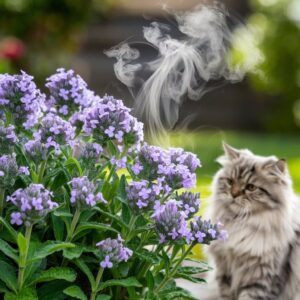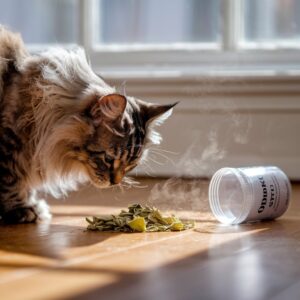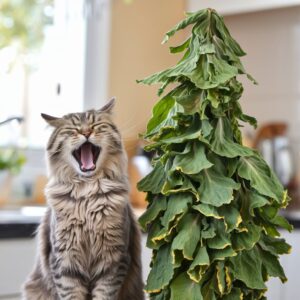High-Quality Catnip: Tips for Avoiding Low-Quality
Lack of Potency and Weak Aroma
One of the most apparent signs of low-quality catnip is the lack of potency. If your cat shows little to no interest in the catnip, it may indicate that it is not high-quality. Additionally, if the catnip does not have a strong aroma, it may indicate that it is not pure or has been sitting on the shelf for too long.
Presence of Stems and Leaves
Low-quality catnip may also contain many stems and leaves, which do not contain as much nepetalactone as the plant’s flowering tops. This can lead to a less effective and enjoyable experience for your cat.
Impurities and Additives
Another sign of low-quality catnip is the presence of impurities or additives. Some manufacturers may add fillers or other substances to their catnip to cut costs or enhance the product’s appearance. These additives can be harmful to your cat and may cause adverse reactions.
Choosing High-Quality Catnip
It’s important to carefully inspect the packaging and choose catnip from pure, organic ingredients to ensure your pet’s safety and enjoyment. By being aware of these signs, you can avoid purchasing low-quality catnip and provide your cat with a safe and enjoyable experience.
 The Benefits of Organic Catnip for Your Feline Friend
The Benefits of Organic Catnip for Your Feline Friend
Organic catnip provides various benefits to your kitty companion. To begin with, organic catnip is grown without synthetic pesticides or fertilisers, so it is devoid of potentially dangerous substances for your cat. This makes organic catnip a safer choice for your pet, especially if they are sensitive or allergic to specific ingredients.
Organic catnip, often grown in more natural and ecological surroundings, offers a higher-quality product overall. This, coupled with its higher potency and scent than non-organic kinds, ensures that your cat is more likely to react strongly and positively when it comes into contact with organic catnip.
The higher concentration of nepetalactone in organic catnip can provide hours of enjoyment and stimulation for your cat, which can benefit their general health.
In addition to being safer and more potent, organic catnip promotes sustainable and environmentally beneficial techniques. By purchasing organic catnip, you support farmers by prioritising ethical and sustainable production practices.
By choosing organic catnip, you benefit your cat and contribute to a healthy environment for all living things. Organic catnip promotes sustainable and environmentally beneficial techniques, supporting farmers in prioritising ethical and sustainable production practices.
Tips for Selecting High-Quality Organic Catnip
When choosing high-quality organic catnip for your feline companion, there are various variables to consider. First, search for catnip made entirely from organic materials. This assures that the product is free of synthetic pesticides, herbicides, and fertilisers that could harm your pet.
Additionally, choose catnip prepared from the plant’s flowering tops, which have the maximum concentration of nepetalactone and are more likely to evoke a significant reaction from your cat. It is also critical to select fresh organic catnip with a strong fragrance. Freshness is essential for catnip, as older or stale catnip can lose its strength over time.
A strong aroma suggests the robust catnip will give your pet a delightful experience. Furthermore, try buying organic catnip from respected brands or suppliers who value quality and purity in their products. Finally, when selecting organic catnip, think about your cat’s tastes.
Remember, each cat is unique and may have specific preferences when it comes to catnip. Some may prefer dried leaves, while others may enjoy catnip-infused toys. By considering your cat’s tastes, you demonstrate your attentiveness and ensure they have the best experience with high-quality organic catnip.
 How to Store High-Quality Catnip to Maintain Its Freshness
How to Store High-Quality Catnip to Maintain Its Freshness
Once you’ve chosen high-quality organic catnip for your kitty friend, you must store it properly to keep it fresh and potent. One of the best ways to do so is to preserve catnip in a sealed container in a cool, dark place. This protects the catnip from light, air, and moisture, preserving its aroma and potency.
Another effective way to store high-quality catnip is to utilize the power of cold temperatures. Storing catnip in the fridge or freezer can significantly extend its freshness. However, using an airtight container is important to prevent the catnip from absorbing odours from the refrigerator or freezer.
If you buy fresh catnip, you can dry it yourself to increase its shelf life. Hang the fresh catnip in a dry, well-ventilated place until it completely dries. Store the dried catnip in a sealed jar in a cold, dark area for later use.
Following these storage guidelines, you can keep your high-quality organic catnip fresh and intense for your feline companion.
Ensuring the Safety of High-Quality Catnip for Your Cat
Monitoring Your Cat’s Reaction
When introducing high-quality organic catnip to your feline friend, it is essential to monitor their reaction. Some cats may respond strongly, while others may show little interest or even exhibit signs of aggression or anxiety.
Precautions to Take
If you notice any adverse reactions, discontinue use and consult with a veterinarian. Moderation is crucial when using high-quality organic catnip, as excessive exposure can lead to overstimulation or digestive issues.
Safe Exposure Guidelines
To prevent potential negative effects, limit your cat’s exposure to catnip to a few times per week. Always supervise your cat when it interacts with high-quality organic catnip-infused toys or products to ensure its safety and prevent accidents or the ingestion of large quantities of catnip.
By taking these precautions and monitoring your cat’s reaction, you can ensure that high-quality organic catnip is a safe and enjoyable experience for your feline friend.
 The Importance of Investing in High-Quality Catnip for Your Cat’s Wellbeing
The Importance of Investing in High-Quality Catnip for Your Cat’s Wellbeing
Investing in high-quality organic catnip benefits your cat’s general health and enjoyment. Catnip provides mental and physical stimulation, allowing cats to remain active and interested. Cats that spend most of their time indoors, away from the elements, would adore this.
High-quality organic catnip can help relieve tension in cats. Cats’ euphoric reactions to catnip can help them relax and unwind, lowering anxiety and increasing overall well-being. Furthermore, providing your kitty buddy with high-quality organic catnip demonstrates your concern for their happiness and enrichment.
Investing in excellent products for your pet improves their overall quality of life and demonstrates your devotion to their well-being. To summarise, high-quality organic catnip benefits your kitty buddy, including cerebral and physical stimulation, stress alleviation, and general enjoyment.
Understanding the difference between high-quality and low-quality catnip, choosing the best products for your pet, storing it correctly, ensuring its safety, and investing in quality products for their well-being will let you give your cherished kitty companion a fun and secure environment with high-quality organic catnip, bringing you joy and satisfaction in seeing them happy and healthy.
For more information on keeping your cat happy and healthy, check out this article on plants that keep stink bugs away. It offers helpful tips for creating a safe and enjoyable environment for your feline friend, including the importance of using high-quality catnip to keep them entertained and stimulated.
FAQs
What is catnip?
Catnip is a mint family herb known for its effects on cats. When cats come into contact with catnip, they may exhibit behaviours such as rolling, rubbing, and purring.
What are the signs of low-quality catnip?
Low-quality catnip may have a dull colour, lack a strong aroma, or contain a lot of stems and leaves. Cats may also show little to no interest in low-quality catnip.
How can I avoid low-quality catnip?
To avoid low-quality catnip, look for products labelled as “organic” or “certified.” It’s also a good idea to purchase catnip from reputable brands or stores specialising in pet products.
What are some alternatives to traditional catnip?
If you’re concerned about the quality of traditional catnip, you can try alternatives such as silver vine, valerian root, or honeysuckle. These plants produce similar effects in cats and may be more readily available in high-quality forms.
References
Discover The Expert’s Guide To Safely Feeding Soup To Cats: Veterinary Tips & Personalized Advice. https://catspatrol.com/is-cats-and-soup-safe/
What is Catnip and Why Do Cats Love It? – Cats Guru. https://www.catsguru.com/what-is-catnip/
Food Puzzles Makes Cats Healthier, Calmer, And Less Aggressive | IFLScience. https://www.iflscience.com/food-puzzles-makes-cats-healthier-calmer-and-less-aggressive-37706
The post Catnip How to Spot Low-Quality and Buy Only the Best appeared first on Unity Pets.
The Article Catnip How to Spot Low-Quality and Buy Only the Best Was Found On https://limitsofstrategy.com
The Article Catnip How to Spot Low-Quality and Buy Only the Best First Appeared ON
: https://ad4sc.com


Comments are closed